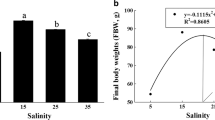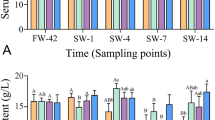Abstract
The objectives of this study were to evaluate the effects of different salinity levels on tissue histology, blood biochemistry, and genes transcription of the GH/IGF system in juvenile golden trout (Oncorhynchus mykiss). Five experimental salinity levels (0, 8, 16, 24, and 32‰) were selected to domesticate juvenile O. mykiss for 7 days. Histological characteristics changed with salinity, including higher ionocites area and epithelium thickness in gills, narrow lumen of collecting tubules in kidneys, and high numbers of goblet cells in the intestines. Similarly, increments in slits, degenerate hepatocytes, and individualization of hepatocytes have been shown in fish reared in the 32‰ salinity group. The lowest triglyceride (TG) and the highest level of total protein (TP) were detected in fish reared at the 32‰ group. The genes transcription of the GH/IGF system altered in response to the increase of salinity. The present results add to the understanding of the physiological responses of O. mykiss on salinity stress and would be helpful in formulating strategies to optimize the aquaculture of this species in environments with fluctuating patterns of salinity.






Similar content being viewed by others
Data Availability
Not applicable. All data generated or analyzed during this study are included in this article.
References
Al-Khashali MS, Al-Shawi S (2013) Effect of salt stress on ALT and AST enzymes activity and cortisol level in adults of Carassius auratus. Pak J Nutr 12(1):97–100. https://doi.org/10.3923/pjn.2013.97.100
Baysoy E, Atli G, Canli M (2013) The effects of salinity and salinity+metal (chromium and lead) exposure on ATPase activity in the gill and intestine of tilapia Oreochromis niloticus. Arch Environ Contam Toxicol 64(2):291–300. https://doi.org/10.1007/s00244-012-9825-9
Bœuf G, Payan P (2001) How should salinity influence fish growth? Comp Biochem Physiol C 130(4):411–423. https://doi.org/10.1016/s1532-0456(01)00268-x
Breves JP, Fujimoto CK, Phipps-Costin SK, Einarsdottir IE, Björnsson BT, McCormick SD (2017) Variation in branchial expression among insulin-like growth-factor binding proteins (igfbps) during Atlantic salmon smoltification and seawater exposure. BMC Physiol 17(1):2. https://doi.org/10.1186/s12899-017-0028-5
Bystriansky JS, Frick NT, Ballantyne JS (2007) Intermediary metabolism of Arctic char Salvelinus alpinus during short-term salinity exposure. J Exp Biol 210(11):1971–1985. https://doi.org/10.1242/jeb.000059
Chen W, Lin H, Li W (2012) Molecular characterization and expression pattern of insulin-like growth factor binding protein-3 (IGFBP-3) in common carp, Cyprinus carpio. Fish Physiol Biochem 38(6):1843–1854. https://doi.org/10.1007/s10695-012-9681-6
Chenari F, Morovvati H, Ghazilou A, Savari A, Ronagh M (2011) Rapid variation in kidney histology in spotted scat Scatophagus argus on exposed to abrupt salinity changes. Iran J Vet Res 12(3):256–261. https://doi.org/10.1093/ilar.52.3.393
Cleetus RI, Rebello VT (2017) Biochemical and histological studies on juvenile tilapia, Oreochromis mossambicus exposed to salinity stress. IJAR 3(9):40–43
Damon SE, Haugk KL, Swisshelm K, Quinn LS (1997) Developmental regulation of Mac25/insulin-like growth factor-binding protein-7 expression in skeletal myogenesis. Exp Cell Res 237(1):192–195. https://doi.org/10.1006/excr.1997.3787
Dawood MA, Koshio S, Ishikawa M, El-Sabagh M, Yokoyama S, Wang W-L, Yukun Z, Olivier A (2017) Physiological response, blood chemistry profile and mucus secretion of red sea bream (Pagrus major) fed diets supplemented with Lactobacillus rhamnosus under low salinity stress. Fish Physiol Biochem 43(1):179–192. https://doi.org/10.1007/s10695-016-0277-4
de Azevedo RV, de Oliveira KF, Flores-Lopes F, Teixeira-Lanna EA, Takishita SS, Tavares-Braga LG (2015) Responses of Nile tilapia to different levels of water salinity. Lat Am J Aquat Res 43(5):828–835. https://doi.org/10.3856/vol43-issue5-fulltext-3
Evans DH, Piermarini PM, Choe KP (2005) The multifunctional fish gill: dominant site of gas exchange, osmoregulation, acid-base regulation, and excretion of nitrogenous waste. Physiol Rev 85(1):97–177. https://doi.org/10.1152/physrev.00050.2003
Fazio F, Marafioti S, Arfuso F, Piccione G, Faggio C (2013) Influence of different salinity on haematological and biochemical parameters of the widely cultured mullet, Mugil cephalus. Mar Freshw Behav Physiol 46(4):211–218. https://doi.org/10.1080/10236244.2013.817728
Fiol DF, Kultz D (2007) Osmotic stress sensing and signaling in fishes. FEBS J 274(22):5790–5798. https://doi.org/10.1111/j.1742-4658.2007.06099.x
Gabillard J-C, Kamangar BB, Montserrat N (2006) Coordinated regulation of the GH/IGF system genes during refeeding in rainbow trout (Oncorhynchus mykiss). J Endocrinol 191(1):15–24. https://doi.org/10.1677/joe.1.06869
Ghazilou A, Chenary F, Morovvati H, Zolgarneine H (2011) Time course of saltwater adaptation in Spotted Scat (Scatophagus argus)(Pisces): A histomorphometric approach. Ital J Zool 78(1):82–89. https://doi.org/10.1080/11250003.2010.491099
Giari L, Manera M, Simoni E, Dezfuli B (2006) Changes to chloride and rodlet cells in gills, kidney and intestine of Dicentrarchus labrax (L.) exposed to reduced salinities. J Fish Biol 69(2):590–600. https://doi.org/10.1111/j.1095-8649.2006.01130.x
Glover DC, DeVries DR, Wright RA (2012) Effects of temperature, salinity and body size on routine metabolism of coastal largemouth bass Micropterus salmoides. J Fish Biol 81(5):1463–1478. https://doi.org/10.1111/j.1095-8649.2012.03385.x
Hassan M, Zakariah M, Wahab W, Muhammad S, Idris N, Jasmani S (2013) Histopathological and behavioral changes in Oreochromis sp. after exposure to different salinities. J Fisheries Livest. Prod 2:1–4. https://doi.org/10.4172/2332-2608.1000103
He Y-f, Wang L-m, Zhu W-b, Dong Z-j, Liu N (2017) Effects of salinity on cold tolerance of Malaysian red tilapia. Aquac Int 25(2):777–792. https://doi.org/10.1007/s10499-016-0077-y
Jasim Basim M, Najim Salah M (2016) Liver of platy Xiphophorus maculatus (gunther, 1986) as an indicator for salinity stress. Int J Zool Res 5(1):91–95
Jumah YU, Traifalgar RFM (2015) Stress response and amino enzymes catabolism of Nile tilapia, Oreochromis niloticus exposed to hyperosmotic culture conditions. Asian Australas J Anim Sci 9(6):379–387. https://doi.org/10.3923/ajas.2015.379.387
Kamei H, Lu L, Jiao S, Li Y, Gyrup C, Laursen LS, Oxvig C, Zhou J, Duan C (2008) Duplication and diversification of the hypoxia-inducible IGFBP-1 gene in zebrafish. PLoS One 3(8):e3091. https://doi.org/10.1371/journal.pone.0003091
Kavya K, Jadesh M, Kulkarni R (2016) Hematology and serum biochemical changes in response to change in saline concentration in fresh water fish Notopterus notopterus. World Sci News 32:49–60
Laverty G, Skadhauge E (2012) Adaptation of teleosts to very high salinity. Comp Biochem Phys A 163(1):1–6. https://doi.org/10.1016/j.cbpa.2012.05.203
Lehtonen TK, Wong BB, Kvarnemo C (2016) Effects of salinity on nest-building behaviour in a marine fish. BMC Ecol 16(1):7. https://doi.org/10.1186/s12898-016-0067-y
Livak KJ, Schmittgen TD (2001) Analysis of relative gene expression data using real-time quantitative PCR and the 2(-Delta Delta C(T)) Method. Methods 25(4):402–408. https://doi.org/10.1006/meth.2001.1262
Madsen SS, Jensen MK, Nhr J, Kristiansen K (1995) Expression of Na(+)-K(+)-ATPase in the brown trout, Salmo trutta: in vivo modulation by hormones and seawater. Am J Phys Regul Integr Comp Phys 269(6):R1339–R1345. https://doi.org/10.1152/ajpregu.1995.269.6.R1339
Magdeldin S, Uchida K, Hirano T, Grau G, Abdelfattah A, Nozaki M (2007) Effects of environmental salinity on somatic growth and growth hormone/insulin-like growth factor-I axis in juvenile tilapia Oreochromis mossambicus. Fish Sci 73(5):1025–1034. https://doi.org/10.1111/j.1444-2906.2007.01432.x
Martinez-Alvarez RM, Hidalgo MC, Domezain A, Morales AE, Garcia-Gallego M, Sanz A (2002) Physiological changes of sturgeon Acipenser naccarii caused by increasing environmental salinity. J Exp Biol 205(23):3699–3706. https://doi.org/10.1023/A:1023875514454
McCormick SD (1996) Effects of growth hormone and insulin-like growth factor I on salinity tolerance and gill Na+, K+-ATPase in Atlantic salmon (Salmo salar): interaction with cortisol. Gen Comp Endocrinol 101(1):3–11. https://doi.org/10.1006/gcen.1996.0002
McCormick SD, Regish AM, Christensen AK (2009) Distinct freshwater and seawater isoforms of Na+/K+-ATPase in gill chloride cells of Atlantic salmon. J Exp Biol 212(24):3994–4001. https://doi.org/10.1242/jeb.037275
Mohammed-Geba K, Mancera JM, Martinez-Rodriguez G (2015) Acclimation to different environmental salinities induces molecular endocrine changes in the GH/IGF-I axis of juvenile gilthead sea bream (Sparus aurata L.). J Comp Physiol B 185(1):87–101. https://doi.org/10.1007/s00360-014-0871-7
Oğuz A (2015) A histological study of the kidney structure of Van fish (Alburnus tarichi) acclimated to highly alkaline water and freshwater. Mar Freshw Behav Physiol 48(2):135–144. https://doi.org/10.1080/10236244.2015.1004838
Radaelli G, Patruno M, Rowlerson A, Maccatrozzo L, Funkenstein B (2005) Cellular localisation of insulin-like growth factor binding protein-2 (IGFBP-2) during development of the marine fish, Sparus aurata. Cell Tissue Res 319(1):121–131. https://doi.org/10.1007/s00441-004-0952-0
Sakamoto T, Hirano T (1993) Expression of insulin-like growth factor I gene in osmoregulatory organs during seawater adaptation of the salmonid fish: possible mode of osmoregulatory action of growth hormone. Proc Natl Acad Sci U S A 90(5):1912–1916. https://doi.org/10.1073/pnas.90.5.1912
Shepherd BS, Drennon K, Johnson J, Nichols JW, Playle RC, Singer TD, Vijayan MM (2005) Salinity acclimation affects the somatotropic axis in rainbow trout. Am J Phys Regul Integr Comp Phys 288(5):R1385–R1395. https://doi.org/10.1152/ajpregu.00443.2004
Shirangi SA, Kalbassi MR, Khodabandeh S, Jafarian H, Lorin-Nebel C, Farcy E, Lignot JH (2016) Salinity effects on osmoregulation and gill morphology in juvenile Persian sturgeon (Acipenser persicus). Fish Physiol Biochem 42(6):1741–1754. https://doi.org/10.1007/s10695-016-0254-y
Tipsmark CK, Luckenbach JA, Madsen SS, Borski RJ (2007) IGF-I and branchial IGF receptor expression and localization during salinity acclimation in striped bass. Am J Phys Regul Integr Comp Phys 292(1):R535–R543. https://doi.org/10.1152/ajpregu.00915.2005
Tipsmark CK, Luckenbach JA, Madsen SS, Kiilerich P, Borski RJ (2008) Osmoregulation and expression of ion transport proteins and putative claudins in the gill of southern flounder (Paralichthys lethostigma). Comp Biochem Phys A 150(3):265–273. https://doi.org/10.1016/j.cbpa.2008.03.006
Tran-Ngoc KT, Schrama JW, Le MT, Nguyen TH, Roem AJ, Verreth JA (2017) Salinity and diet composition affect digestibility and intestinal morphology in Nile tilapia (Oreochromis niloticus). Aquaculture 469:36–43. https://doi.org/10.1016/j.aquaculture.2016.11.037
Tsui WC, Chen JC, Cheng SY (2012) The effects of a sudden salinity change on cortisol, glucose, lactate, and osmolality levels in grouper Epinephelus malabaricus. Fish Physiol Biochem 38(5):1323–1329. https://doi.org/10.1007/s10695-012-9620-6
Vargas-Chacoff L, Saavedra E, Oyarzún R, Martínez-Montaño E, Pontigo J, Yáñez A, Ruiz-Jarabo I, Mancera J, Ortiz E, Bertrán C (2015) Effects on the metabolism, growth, digestive capacity and osmoregulation of juvenile of Sub-Antarctic Notothenioid fish Eleginops maclovinus acclimated at different salinities. Fish Physiol Biochem 41(6):1369–1381. https://doi.org/10.1007/s10695-015-0092-3
Wong M, Woo N (2006) Rapid changes in renal morphometrics in silver sea bream Sparus sarba on exposure to different salinities. J Fish Biol 69(3):770–782. https://doi.org/10.1111/j.1095-8649.2006.01148.x
Wong MKS, Tsukada T, Ogawa N, Pipil S, Ozaki H, Suzuki Y, Iwasaki W, Takei Y (2017) A sodium binding system alleviates acute salt stress during seawater acclimation in eels. Zool Lett 3(1):22. https://doi.org/10.1186/s40851-017-0081-8
Yin S-J, Zhang L, Zhang L, Wan J, Song W, Jiang X, Park Y-D, Si Y-X (2018) Metabolic responses and arginine kinase expression of juvenile cuttlefish (Sepia pharaonis) under salinity stress. Int J Biol Macromol 113:881–888. https://doi.org/10.1016/j.ijbiomac.2018.03.036
Funding
This work was supported by the Yunnan Fundamental Research Projects (grant number 2017FD077) and the National Natural Science Foundation of China (grant number 31602141).
Author information
Authors and Affiliations
Contributions
All authors contributed to the study design. Material preparation was performed by Baoliang Bi, Dan Jia, Lingfu Kong and Xiaowen Wang. Sampling and data collection were performed by Baoliang Bi, Yanhua Su, Hua Rong, Xiangwei Wu and Zhuoyong Hu. Data analysis was performed by Yu Gao, Yanhua Su, Xiangwei Wu. All authors contributed to the discussion and interpretation of the results. The first draft of the manuscript was written by Baoliang Bi and Qing Hu. All authors revised and commented on all versions of the manuscript, and all authors read and approved the final manuscript.
Corresponding author
Ethics declarations
Ethical approval
The usage of fish was in strict accordance with the recommendations of the Guidelines for the Use of Experimental Animals of Yunnan Agricultural University. The protocol for animal care and handling used in this study was approved by the Committee on the Ethics of Animal Experiments of Yunnan Agricultural University.
Conflict of interest
The authors declare that they have no conflict of interest.
Additional information
Publisher’s note
Springer Nature remains neutral with regard to jurisdictional claims in published maps and institutional affiliations.
Rights and permissions
About this article
Cite this article
Bi, B., Gao, Y., Jia, D. et al. Growth influence of juvenile golden trout (Oncorhynchus mykiss) in different osmotic conditions: implications for tissue histology, biochemical indicators, and genes transcription involved in GH/IGF system. Fish Physiol Biochem 47, 583–597 (2021). https://doi.org/10.1007/s10695-021-00933-w
Received:
Accepted:
Published:
Issue Date:
DOI: https://doi.org/10.1007/s10695-021-00933-w




